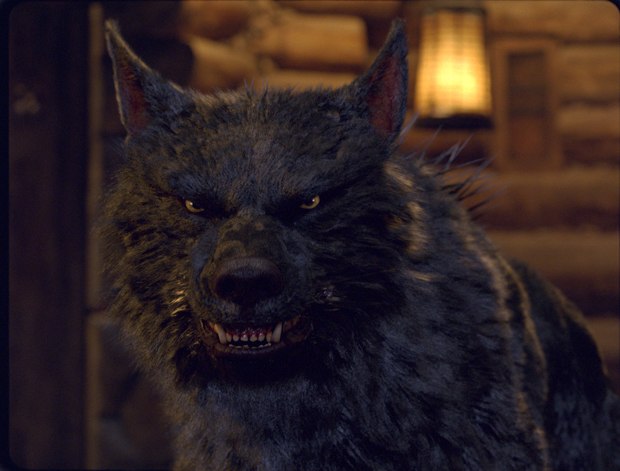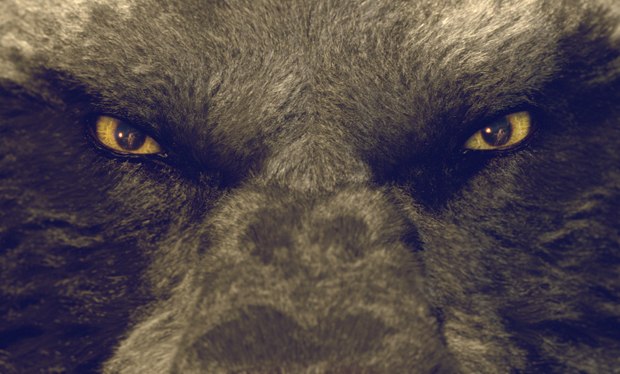Read how Rhythm & Hues had fun getting darker with Red Riding Hood.
Werewolves, like vampires, are all the rage, of course. And director Catherine Hardwicke wanted a more graphic, ferocious and unpredictable beast for her Red Riding Hood.
According to Jeff Okun, the onset visual effects supervisor, Hardwicke had a collection of every werewolf reference there is. "We looked at all these photos and drawings and things off the internet and talked about each and every one of them in a lot of detail," he suggests. "Why it worked or it didn't work; what worked for its time and looks terrible now. And we talked a lot about transformations and decided early on that we weren't going to do a transformation. We've never seen a transformation that was really well done. The best one still being the Werewolf of London, but, for our story, it's not really about a transformation: it's about the mystery of who the wolf is. It would've taken away from the arc a little bit and been less special. And in terms of the design of the wolf, we tried to walk a very bizarre tightrope between something that's very beautiful and intelligent and something that is really scary and has visual potential of death about it. That resulted in a creature with both short and long hair and lots of muscles with a lot of traditional wolf features. We also shot animation reference of all the actors. And when we were animating, we used little bits of each of the actors so that all of their individual tics would be in there. We really pay conscious attention to make sure the wolf pays off."
In fact, Okun says the wolf is a combination of smooth operator and used car salesman, which reveals itself in phases: the first is a series of blurs showing mostly muscle and teeth; the second is all about trying to convince Valerie (Amanda Seyfried) to come away with it; and the final is trying to get out of a dilemma. "The animation is a combination of rodeo horse and hyenas on the attack," Okun describes.
Rhythm & Hues was tasked with creating the wolf under the animation direction of Craig Talmy. He echoes Okun in describing this as a different kind of beast. "It's stylized and very monstrous-looking. But it is not the biped human form that you often see in these films. The other difference is that our wolf spends the majority of screen time trying to be as inviting and calm and supportive of Valerie as he can. The wolf is trying to seduce her into coming away with it. We don't know. You never see werewolves try to reason and romance somebody.
"Our charge was to show the wolf never having any human physical form or behaving like a human but showing as much human intelligence as possible. We looked at tons of reference of attacking dogs, attacking wolves, lots and lots of wolf reference in general. There were some spectacular documentaries that were of help to us. We also looked at large cats because some of their muscle structure and attack methodology was something we could borrow from. In our final use of that final reference, we made sure we got our mechanics as accurate to a real wolf as much as possible. Then we made sure our behavior in portraying an intelligence level was as accurate as we could make it. Watching guard dogs or wolves attack, they do it from a predatory or instinctual way. We wanted to give purpose to the killings that we did. Our wolf looks around to see who the next best victim is in regards to its safety and security or moving the story along. And so mechanics comes from reference; intelligence comes from humans and obviously Catherine's requests and direction. The rest of it is fun brutality."
Indeed, this was a far cry from Yogi Bear or Alvin and the Chipmunks -- less cartoony and more naturalistic. "Here at Rhythm & Hues, we're the talking animal heroes of all time, but the first thing Catherine said was this isn't a talking animal; it communicates with its mind power. And that distilled down eventually to: there shouldn't be any muscle movement in the face; there should be no expression whatsoever. We don't want it to look as though he's struggling to talk. Honestly, that keeps pretty well to the rest of the style in the movie and is an important story point in terms of signaling that Valerie's the chosen one, which puts her in jeopardy with her friends and neighbors in the village when they learn that the wolf speaks telepathically only to her. Everything's very understated and percolating just under the lid."
Eyes become important as well: a subtle squint, the disarming raise of an eyebrow or a disapproving crunch down. But Rhythm & Hues did it very subtly, perhaps even too slight for some viewers, Talmy contends. "It is different from our talking animal pipeline that we're used to working with here. So it was a lot of fun for animators to have an animal that they didn't have to make talk."
Using the proprietary Voodoo package, however, attention to fur was vital. "It is uniquely combed and the groom is different; the length is different; whether it's matted from having been rubbing up against a tree full of sap or some encrusted blood still in the jaw line from a kill just made; some areas of him are very feral-looking while other areas are very clean and glossy and pretty. And so we're grooming all of those elements into his fur, either scene by scene or as one global groom."
Talmy says the greatest satisfaction came from finding new ways of performance that exceeded Hardwicke's expectations. For instance, the werewolf is supposed to stare down the horse of wolf hunter Solomon (played by the always fascinating Gary Oldman). But the intimidation was intended to come from a powerful stillness. Instead, Talmy and his animators experimented with a different approach.
"We thought there was just something missing from the shot, so we tried this idea where the wolf would poise itself, pull itself up and attack the horse and kill it," he recounts. "Our rationale was that the wolf wanted to first toy with Solomon: get him away from his sword; make him have to be subordinate; have him struggle to get up; then we could do battle with him and ultimately he dies. And so we had some semblance of psychology and everybody liked what we did. It's always fun to bring some alternative versions to the client and they just think it's the greatest thing because it's something they never thought of."
Meanwhile, there was another envelope pushing moment that made Hardwicke jump from her chair and yell, "Rad! That's bad-ass!"
Talmy says working on the cute stuff is fun, of course, but many of the animators play video games, so sooner or later they "just want to hurt something. And when there's a project with a monster, they all come running to see who can get on it."
Bill Desowitz is senior editor of AWN & VFXWorld.










